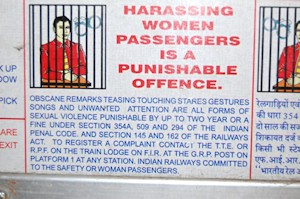2020 February
2018 December August June February
2017 December September June March
2016 November August June March
2015 December October July May February
2014 December October July April February
2013 December October August May February
2012 December September July April February
2011 December September July April February
from the December, 2012 issue of Kiai!
Standing Up to Street Harassment in India
By Erin H. Epperson
Erin H. Epperson is a PhD Candidate at the University of Chicago in the South Asian Languages and Civilizations department. She holds a green belt in Seido Karate and trains at Thousand Waves. She is currently in India pursuing research for her doctoral dissertation.

Erin Epperson (left) with Tapu
India has a major problem with street harassment. For female foreigners however, street harassment is often a daily occurrence, especially if you are white. Much (though certainly not all) of it stems from the characterization of white women in Bollywood and Hollywood films as sexually loose. Since white women are not considered to ‘belong’ to Indian culture, they are likewise excluded from the social norms that protect many Indian women from the frequency and intensity of this harassment.
During my second trip to India, in 2011, I lived with a family in Jaipur, Rajasthan. In order to deflect street harassment, I followed all of the well-intended advice given by our program leaders on the “appropriate” way to dress and behave. I wore Indian clothing and even covered my hair and neck with a dupatta (Indian scarf/shawl)—not out of convention, since it was not the norm in Jaipur, but in order to minimize the degree to which my pale skin and hair was visible to male passers-by. I had also learned a “trick” that if I turn my face away from the harasser while covering my face with my dupatta, it communicates that the man has violated the woman’s modesty and generally embarasses the harasser into turning away.
However, during my current trip, initially I experienced an average of 4-7 incidents of street harassment during the brief, 20-minute walk to my research site in Sarnath (a town just outside of Varanasi). These incidents generally consisted of leering or teasing looks, but often included provocative gestures, teasing or obscene comments, and in some cases threatening body positioning – men and boys following me or cutting me off with their bicycles or motorbikes. Every one of these instances left me feeling angry and violated. I decided to start a blog for female travelers to discuss these issues (http://travelingwhilefemale.blogspot.com) and started reaching out to other women traveling in South Asia, including other female scholars and students. I also started building up my vocabulary in Hindi, which I was already quasi-fluent in, and started practicing phrases for more effective boundary-setting. Over time as my tactics improved, the harassment began to decrease, though it has never stopped.
As I have experienced and discussed in my blog posts, the norms governing social interaction in India differ from those in the US. One difference is the fact that staring is not taboo in India, so Indian men and women both might stare uninhibitedly at foreigners out of curiosity or boredom and not necessarily to harass someone. Likewise, at Thousand Waves and in many US based self-defense programs, we teach that assertive responses – versus passive or aggressive ones – are best. My experience in India has shown me that here, it is often much more effective to be loud, obnoxious and even aggressive in tone, firmly reprimanding harassers for violating their own cultural norms. Public embarrassment of harassers is a much more effective tactic in India than polite but firm boundary-setting. Because of the foreigner-targeting, I have found that responding in the harasser’s native tongue is the most effective, since it more effectively reminds them of their violation of norms, though English is also effective.
The youngest daughter of the family that runs my Sarnath guesthouse asked me to teach her self defense. So I met with her to teach her some of the basics covered in our Five Fingers of Self-Defense (Think, Yell, Run, Fight, Tell) courses. When I started on material from the “Yell” finger, I was both pleasantly surprised and dismayed to realize Tapu (17) already had an amazing command of verbal boundary-setting skills. I recalled that in the Five Fingers classes I had either attended or assisted with, many women often appeared uncomfortable or embarassed to practice verbal boundary setting skills, and needed encouragement from TW staff. Tapu displayed no such embarrassment. The dismay came when she told me why. “Here, it’s very necessary,” Tapu said. “Boys here are not so good. They will do all sorts of things…like this—” Tapu demonstrated by walking up from behind me and firmly stroking the front of my thigh as she passed. “So you have to say something right then.”
Street harassment, often called “eve teasing” in India, is not considered a socially acceptable behavior, but is often accepted as inevitable due to the assumption that “boys will be boys.” Attempts are being made from within India to reform these attitudes (The Blank Noise project and Safe Delhi come to mind), though so far there has been greater success with more “protective” types of reforms such as women-only train or subway cars, women-only taxis with female drivers, and an increased availability of self-defense seminars. Our sister Seido branch school in Delhi (Seido Karate Noida) led by Senpai Rahul Agarwal is particularly active in conducting self-defense  seminars for businesses and local residents in the South Delhi area. On a recent train ride from Varanasi to Delhi, I spotted a sign on the exit-door printed side-by-side in both English and Hindi that reads,
seminars for businesses and local residents in the South Delhi area. On a recent train ride from Varanasi to Delhi, I spotted a sign on the exit-door printed side-by-side in both English and Hindi that reads,
Harassing Women Passengers is a Punishable Offense: obscene remarks, teasing, touching, stares, gestures, songs and unwanted attention are all forms of sexual violence, punishable by law by up to two years or a fine under Section 354 A, 509 and 294 of the Indian Penal Code and section 145 and 162 of the railways Act.
While legislation like this remains under-enforced, I think it is encouraging to see written in a public place that many of the kinds of street harassment that many women experience in US are actually illegal under the Indian Penal Code and in theory punishable. Reflecting on the situation in India, like other countries known for street harassment problems (Japan, Italy, Egypt, and so forth), I am reminded of a line from Tony Kushner’s musical Caroline or Change, “Change come fast, and change come slow. But change come.”
